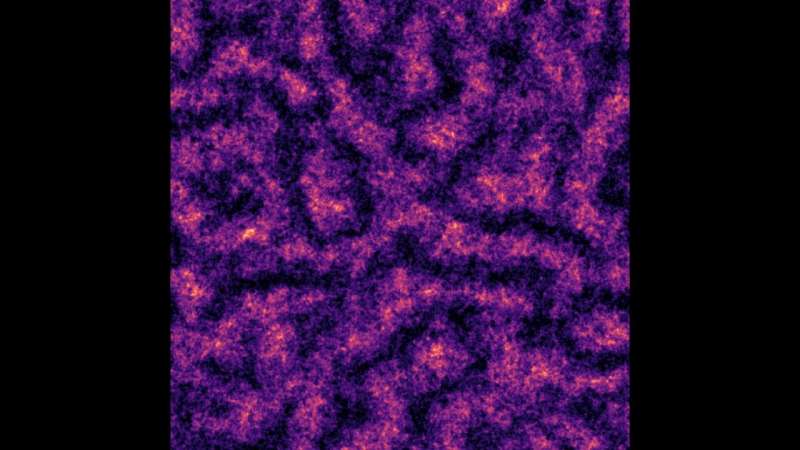November 6, 2023 feature
This article has been reviewed according to Science X's editorial process and policies. Editors have highlighted the following attributes while ensuring the content's credibility:
fact-checked
peer-reviewed publication
trusted source
proofread
From supersolid to microemulsion: Exploring spin-orbit coupled Bose-Einstein condensates

In a new study, researchers from the University of California, Santa Barbara, (UCSB) have reported the discovery of a spin microemulsion in two-dimensional systems of spinor Bose-Einstein condensates, shedding light on a novel phase transition marked by the loss of superfluidity, complex pseudospin textures, and the emergence of topological defects.
A Bose-Einstein (B-E) condensate is a state of matter that occurs at extremely low temperatures, where bosons, such as photons, become indistinguishable and behave as a single quantum entity, forming a superfluid or superconducting state.
B-E condensates can exhibit unique quantum properties, such as a spin microemulsion. When the internal spin states of atoms in a B-E condensate are coupled to their motion, a unique phase called a spin microemulsion can emerge.
This phase involves atoms organizing themselves into patterns based on their spin states, similar to how microemulsions form in soft matter systems.
Microemulsions and spin-orbit coupling
The concept of microemulsions is not new; they are typically found in synthetic soft matter systems. These phases emerge when two immiscible species (like oil and water) form enriched domains while a third minority component stabilizes their interfaces, like a surfactant.
However, the emergence of a spin microemulsion in the realm of quantum physics has never been seen.
Ethan McGarrigle, lead author and Ph.D. Candidate at the Department of Chemical Engineering UCSB said to Phys.org, "A quantum microemulsion analog phase has been theorized to exist in two-dimensional electronic systems, where microemulsion-like correlated charge domains would appear; however, it has never been observed or substantiated by numerical or experimental evidence."
The researchers employed advanced field-theoretic simulations (FTS) to investigate the transition of a low-temperature stripe phase with supersolid characteristics.
As the temperature rises, this stripe phase transforms into what the researchers term a spin microemulsion. The stripe phase is a specific configuration of atoms within the B-E condensate where they form a striped pattern.
In the spin microemulsion phase, atoms self-organize based on their internal spin states, akin to the formation of microemulsions in soft matter systems.
Dr. Glenn Fredrickson, the principal investigator and Distinguished Professor of Chemical Engineering and Materials at UCSB, clarified, "This microemulsion phase occurs when the motion of each atom is coupled to its internal spin state, resulting in a spin-orbit coupling effect."
The key player in this phenomenon is the isotropic two-dimensional Rashba spin-orbit coupling, which is the interaction between the atom's spin and its motion.
Dr. Fredrickson continued, "In B-E condensates, atoms collectively minimize their energies at specific, preferred momenta. As a result, spin-orbit coupled B-E condensate systems can host a standing-wave stripe superfluid state, which has been argued to possess supersolid character and is described as a superfluid liquid crystal analog."
Imagine it as a pattern or wave-like alignment of atoms within the condensate. This state is unique because it combines the characteristics of a superfluid and a crystal, a phenomenon known as supersolidity. It's as if the atoms behave like waves, aligning in a structured manner.
Kosterlitz–Thouless transitions and future work
In their study, the researchers simulated this stripe superfluid state at various temperatures, leading to the discovery of the spin microemulsion above a critical temperature.
Dr. Fredrickson explained, "McGarrigle applied FTS methods to spin-orbit coupled Bose-Einstein condensates and made the computational discovery that the previously known spin stripe (supersolid) phase melts upon heating into a spin microemulsion before transforming into a normal fluid."
"The findings reveal that the spin microemulsion bears qualitative similarity to bicontinuous microemulsions found in room-temperature oil/water/surfactant mixtures."
Moreover, their findings suggest that the thermal phase transition or melting of the superfluid stripe liquid crystal analog shares similarities with well-established Kosterlitz–Thouless transitions observed in classical liquid crystal films and planar magnets.
In Kosterlitz-Thouless transitions, the shift from one phase to another in two-dimensional systems occurs when vortex-antivortex pairs, which are topological defects, become unbound. This results in a change in the system's order or behavior.
This analogy offers insights into understanding the behavior of two-dimensional systems of Rashba spin-orbit coupled bosons.
The discovery of a quantum spin microemulsion has illuminated a novel phase transition marked by the loss of superfluidity, complex pseudospin textures, and the emergence of topological defects. The implications of this finding reach deep into the realms of quantum physics and soft matter systems.
However, many questions remain. The precise mechanism of how the stripe superfluid phase melts in the system, characterized by full vortices, half-vortices, pseudospin domain walls, and pseudospin skyrmions, presents a compelling challenge for future research.
Speaking of future research plans of the Fredrickson group, McGarrigle said, "We plan to investigate the thermodynamic stability of the spin microemulsion concerning various system parameters, such as spin-orbit coupling anisotropy, miscibility of atoms in different pseudospin states, and pseudospin polarization."
"While our initial work explored immiscible conditions and isotropic Rashba spin-orbit coupling, we plan to extend our numerical analysis to wider conditions. We'll investigate anisotropy tolerance in the spin-orbit coupling scheme, the spin microemulsion's presence in miscible conditions, and its response to uneven pseudospin state populations. This research will guide experimentalists in realizing this phase," he concluded.
The findings of the study are published in Physical Review Letters.
More information: Ethan C. McGarrigle et al, Emergence of a Spin Microemulsion in Spin-Orbit Coupled Bose-Einstein Condensates, Physical Review Letters (2023). DOI: 10.1103/PhysRevLett.131.173403.
Journal information: Physical Review Letters
© 2023 Science X Network





















